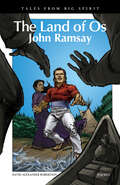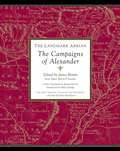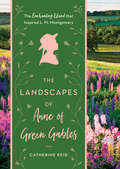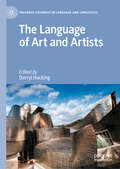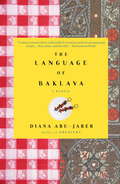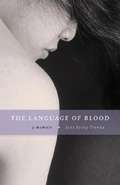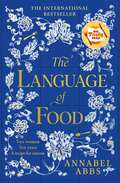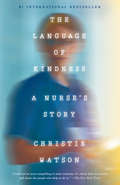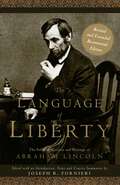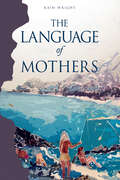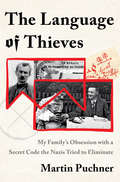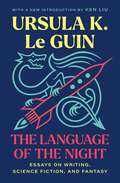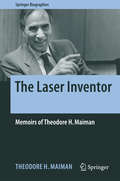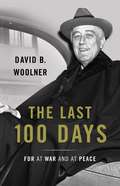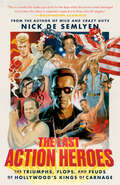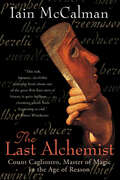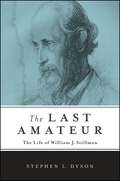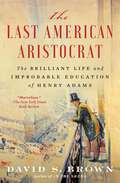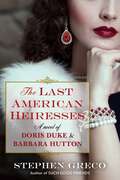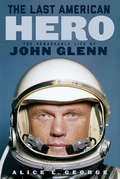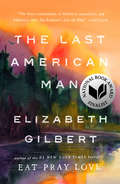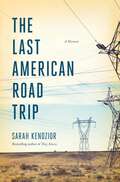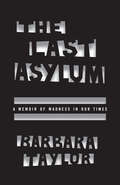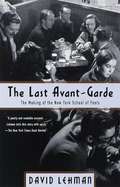- Table View
- List View
The Land of Os: John Ramsay (Tales from Big Spirit)
by David A. RobertsonWhen Richard's class from Big Spirit School takes a canoe trip, he and his classmates chance upon an elderly woman. She tells them the story of her grandfather, John Ramsay, of the Sandy Bar community on Lake Winnipeg. Ramsay's land was taken by the government and given to the new settlers from Iceland who arrived there in 1875. Yet many owed their survival to Ramsay, who helped them through freezing winters, hunger, and a devastating smallpox epidemic.The Land of Os is one book in the Tales from Big Spirit series. Tales from Big Spirit is a unique seven-book graphic novel series that delves into the stories of seven great Indigenous heroes from Canadian history—some already well known and others who deserve to be. Designed to correspond to grades 4–6 social studies curriculums across Canada, these full colour graphic novels could be used in literature circles, novel studies, and book clubs to facilitate discussion of social studies topics. These books will help students make historical connections while promoting important literacy skills.
The Land of Rowan Oak: An Exploration of Faulkner's Natural World
by Ed CroomThe plants and landscape at Rowan Oak are the “little postage stamp of soil” that William Faulkner owned, walked, and tended for over thirty years during the writing of many of his short stories and novels. Faulkner saw and smelled the earth and listened to sounds from the cultivated grounds and the surrounding woods. This is the place that offered him refuge for writing and provided him food from its garden, fruit and nut trees, and pasture for his horses and a milk cow. Rowan Oak boasts a diverse landscape, encompassing an aristocratic eastern redcedar-lined drive and walk as well as hardy ornamental shrubs, trees, pastures, and a hardwood forest with virgin timber. More than fifty years after Faulkner's death, Rowan Oak remains a sanctuary and a place of mystery and beauty nestled in the midst of Oxford, Mississippi. The photographs in The Land of Rowan Oak are botanist Ed Croom's exploration and documentation of the changes in the plants and landscape over more than a decade. Croom encountered early morning mists, the summer heat and haze, and even rare snowfalls in his near-daily walks on the grounds. His photographs record a decaying fence line, trees and plants that have since disappeared, and the newly restored sunken garden. This book honors the land Faulkner loved. While Faulkner's novels have left an indelible legacy in southern and American letters, the landscape of his beloved home also serves as a record of the botanical history of this most storied corner of the American literary South.
The Landmark Arrian: The Campaigns Of Alexander
by Robert B. Strassler James RommThe Landmark Arrian is an important new edition of The Campaigns of Alexander, the most authoritative ancient account of one of the world's most brilliant military leaders. During twelve years of continuous campaigns, Alexander conquered an empire that stretched from the shores of the Adriatic to the edge of modern India. Arrian's history of those conquests, the most reliable and detailed account to emerge from the ancient world, is a work that will fascinate readers interested in classical studies, the history of warfare, and the origins of East-West tensions that still simmer today in Iraq, Iran, and Afghanistan. Drawing on Ptolemy's memoirs and other sources that have not survived antiquity, Arrian's portrait of Alexander is unmatched for its accuracy and immediacy. Having served as a high Roman official with command of an army, Arrian had a unique perspective on Alexander, imbued with a level of understanding that only firsthand military experience can provide. In the richly illustrated and annotated style of the Landmark series. The Campaigns of Alexander, which features an engaging and eloquent new translation by Pamela Mensch, brings together some of the preeminent classics scholars at work today to create what is certain to be the definitive edition of this essential work of history.
The Landscapes of Anne of Green Gables: The Enchanting Island that Inspired L. M. Montgomery
by Catherine Reid“This book will be treasured by Montgomery’s legions of fans.” —Carolyn Strom Collins, author of The Anne of Green Gables TreasuryThe Landscapes of Anne of Green Gables explores L. M. Montgomery’s deep connection to the landscapes of Prince Edward Island that inspired her to write the beloved Anne of Green Gables series. From the Lake of Shining Waters and the Haunted Wood to Lover’s Lane, you’ll be immersed in the real places immortalized in the novels. Using Montgomery’s journals, archives, and scrapbooks, Catherine Reid explores the many similarities between Montgomery and her unforgettable heroine, Anne Shirley. The lush package includes Montgomery’s hand-colorized photographs, the illustrations originally used in Anne of Green Gables, and contemporary and historical photography.
The Language of Art and Artists (Palgrave Advances in Language and Linguistics)
by Darryl HockingThis book brings together the research of leading scholars who explore the complex interplay between language and art. Employing a diversity of methods—including systemic functional linguistics, corpus analysis, multimodal analysis, genre analysis, discourse analysis, and cognitive linguistics—this edited collection offers fresh perspectives on the role of textual practices in shaping artistic production, interpretation, and engagement across a range of cultural and institutional contexts. The chapters examine a wide range of written and spoken texts, including artists&’ statements, art reviews, painting titles, museum press releases, artists&’ websites, guided tours, audio descriptions, and artist talks. This timely volume is relevant for students, teachers, and researchers in language and applied linguistics, discourse analysis and visual arts, as well as those in the areas of art theory and curatorial studies. It will also appeal to academic literacies and ESP (English for Specific Purposes) practitioners supporting visual arts students worldwide.
The Language of Baklava
by Diana Abu-JaberDiana Abu-Jaber’s vibrant, humorous memoir weaves together stories of being raised by a food-obsessed Jordanian father with tales of Lake Ontario shish kabob cookouts and goat stew feasts under Bedouin tents in the desert. These sensuously evoked repasts, complete with recipes, in turn illuminate the two cultures of Diana's childhood–American and Jordanian–while helping to paint a loving and complex portrait of her impractical, displaced immigrant father who, like many an immigrant before him, cooked to remember the place he came from and to pass that connection on to his children. The Language of Baklavairresistably invites us to sit down at the table with Diana’s family, sharing unforgettable meals that turn out to be as much about “grace, difference, faith, love” as they are about food. From the Trade Paperback edition.
The Language of Blood
by Jane Jeong TrenkaAn adoptee's search for her identity takes her from Minnesota to Korean and back as she seeks to resolve the dualities that have long defined her life: Korean-born, American-raised, never fully belonging to either culture. This evocative memoir explores the myriad facets of personal and cultural identity.
The Language of Food: "Mouth-watering and sensuous, a real feast for the imagination" BRIDGET COLLINS
by Annabel Abbs'A sensual feast of a novel, written with elegance, beauty, charm and skill in a voice that is both lyrical and unique' Santa Montefiore Eliza Acton, despite having never before boiled an egg, became one of the world&’s most successful cookery writers, revolutionizing cooking and cookbooks around the world. Her story is fascinating, uplifting and truly inspiring.Told in alternate voices by the award-winning author of The Joyce Girl, and with recipes that leap to life from the page, The Language of Food by Annabel Abbs is the most thought-provoking and page-turning historical novel you&’ll read this year, exploring the enduring struggle for female freedom, the power of female friendship, the creativity and quiet joy of cooking and the poetry of food, all while bringing Eliza Action out of the archives and back into the public eye. &‘I love Abbs&’s writing and the extraordinary, hidden stories she unearths. Eliza Acton is her best discovery yet&’ Clare Pooley'A literary - and culinary - triumph!' Hazel Gaynor &‘Exhilarating to read - thoughtful, heart-warming and poignant, with a quiet intelligence and elegance that does its heroine proud&’ Bridget Collins 'A sumptuous banquet of a book that nourished me and satisfied me just as Eliza Acton&’s meals would have... I adored it' Polly Crosby &‘Wonderful... Abbs is such a good story teller. She catches period atmosphere and character so well&’ Vanessa Nicolson 'Two of my favourite topics in one elegantly written novel - women&’s lives and food history. I absolutely loved it' Polly Russell 'A story of courage, unlikely friendship and an exceptional character, told in vibrant and immersive prose' Caroline Scott &‘Richly imagined and emotionally tender&’ Pen Vogler 'Characters that leap off the page, a fascinating story and so much atmosphere, you feel you're in the kitchen with Eliza - I loved it.' Frances Quinn 'Clever, unsentimental, beautifully detailed and quietly riveting' Elizabeth Buchan, author of Two Women in Rome
The Language of Kindness: A Nurse's Story
by Christie WatsonA moving, lyrical, beautifully-written portrait of a nurse and the lives she has touched Christie Watson spent twenty years as a nurse, and in this intimate, poignant, and remarkably powerful book, she opens the doors of the hospital and shares its secrets. She takes us by her side down hospital corridors to visit the wards and meet her unforgettable patients. In the neonatal unit, premature babies fight for their lives, hovering at the very edge of survival, like tiny Emmanuel, wrapped up in a sandwich bag. On the cancer wards, the nurses administer chemotherapy and, long after the medicine stops working, something more important--which Watson learns to recognize when her own father is dying of cancer. In the pediatric intensive care unit, the nurses wash the hair of a little girl to remove the smell of smoke from the house fire. The emergency room is overcrowded as ever, with waves of alcohol and drug addicted patients as well as patients like Betty, a widow suffering chest pain, frail and alone. And the stories of the geriatric ward--Gladys and older patients like her--show the plight of the most vulnerable members of our society. Through the smallest of actions, nurses provide vital care and kindness. All of us will experience illness in our lifetime, and we will all depend on the support and dignity that nurses offer us; yet the women and men who form the vanguard of our health care remain unsung. In this age of fear, hate, and division, Christie Watson has written a book that reminds us of all that we share, and of the urgency of compassion.
The Language of Liberty: The Political Speeches And Writings Of Abraham Lincoln:bicentennial Edition (Gateway Heritage Series)
by Joseph R. FornieriThe Civil War is a defining event in American history and Abraham Lincoln is the central figure of both the Civil War and American history. In his struggle to preserve the Union and redeem the nation from the original sin of slavery, Abraham Lincoln provided the most compelling expression of the American Dream and the preeminent justification of the American regime. Indeed, at Gettysburg he distilled the very essence of the nation's political creed. His political thought and leadership are of enduring significance to democracy at home and abroad. <P><P>To further appreciate and perpetuate Lincoln's legacy, The Language of Liberty offers the definitive one-volume collection of the Sixteenth President's speeches and writings. Unlike so many other collections, in which Lincoln's speeches and writings have been substantially edited, this volume provides a comprehensive selection of the Sixteenth President's most important speeches and writings in their entirety.The volume is conveniently divided both chronologically and thematically into five periods/chapters from 1832-1865. <P><P>A final chapter offers a compilation of Lincoln's speeches and writings on the theme of religion and politics. Each speech is preceded by an informative head-note, which places Lincoln's words in context for the reader. In addition, each period/chapter includes a concise historical, political, and biographical overview of the major events in Lincoln's life and the life of the nation, thereby providing an even wider context for understanding the Sixteenth President's language of liberty. <P><P>To assist the reader, crucial terms, dates, events and issues of the Civil War have been defined. Also unique to this volume is the final section on Lincoln's Political Faith, which includes an offering of his public and private utterances on religion, and a definition of this political faith based upon the first principles of the Declaration of Independence.A selected bibliography of secondary sources has been included for further reading on various topics related to the Sixteenth President. <P><P>Finally, the volume includes an extensive introduction on Lincoln's Prudent Leadership and his application of the natural law to the circumstances of the Civil War Era. Indeed, this introduction provides a crucial understanding of the relationship between Lincoln's political thought and political action, between the world of theory and practice. <P><P>In sum, The Language of Liberty provides an indispensable guide to the lay reader, the Lincoln aficionado, and the scholar. All now have access to a single volume collection of his great political speeches and writings with unedited versions, concise historical overviews, and scholarly reflections on the enduring significance of Lincoln's political philosophy.
The Language of Mothers
by Rain WrightThe Language of Mothers is a hybrid memoir grounded in the power of prose and poetry. It is an imaginative tapestry of women' s storytelling that punctures narrative craft to illuminate the inheritance of domestic trauma and the voicing of familial stories that are healing spaces that carry through time. The Language of Mothers is about two mothers caught in abusive relationships, impoverished with children, with few avenues of escape. These stories shed light on the culture of American motherhood as a failure for women, perpetuating a system of patriarchal ideals that only values the nuclear family as whole spaces of abundance, love, and worth. At nineteen, Rain Wright' s mother left Dronfield, England, traveling through Europe before landing in New York in the turbulent 1960s. Swept up in the changing societal wave, Elizabeth, her mother travels to California, where she meets her future abuser, Rain' s father. This memoir is the story of Elizabeth' s courageous escape with three young children, and it is the story of Rain' s escape decades later. The Language of Mothers navigates the inheritance of trauma, finding that storytelling and art, for both women, become the impetus for healing. Elizabeth packs her children' s belongings in black plastic bags and hides them in the brush along Elk Ridge Road, in California, making her daring escape with the help of friends and an ex-lover. She flies with her children across an ocean to the safety of Hawai?i, where she finds art, lomi lomi, music, and security. After Elizabeth' s passing from breast cancer in 1996, her stories, inherited from years of car rides around Hawai?i Island, are the language of mythmaking. The Language of Mothers is an intimate look at why women stay too long in abusive relationships and an act of defiance and regenerative love. Rain' s story is a tapestry of early childhood trauma as witness to her mother' s abuse, domestic terror at the hands of her children' s father, and her own escape narrative. The Language of Mothers deeply sees the aftereffects of domestic abuse, including her eldest daughter' s suicide attempts, her middle daughter' s strive for perfection, and her youngest daughter' s need for control through anorexia. Women' s stories can heal. Rain interweaves traumatic parts of her past but recounts acts of love, telling her daughters stories and becoming their storyteller.
The Language of Thieves: My Family's Obsession With A Secret Code The Nazis Tried To Eliminate
by Martin PuchnerTracking an underground language and the outcasts who depended on it for their survival. Centuries ago in middle Europe, a coded language appeared, scrawled in graffiti and spoken only by people who were "wiz" (in the know). This hybrid language, dubbed Rotwelsch, facilitated survival for people in flight—whether escaping persecution or just down on their luck. It was a language of the road associated with vagabonds, travelers, Jews, and thieves that blended words from Yiddish, Hebrew, German, Romani, Czech, and other European languages and was rich in expressions for police, jail, or experiencing trouble, such as "being in a pickle." This renegade language unsettled those in power, who responded by trying to stamp it out, none more vehemently than the Nazis. As a boy, Martin Puchner learned this secret language from his father and uncle. Only as an adult did he discover, through a poisonous 1930s tract on Jewish names buried in the archives of Harvard’s Widener Library, that his own grandfather had been a committed Nazi who despised this "language of thieves." Interweaving family memoir with an adventurous foray into the mysteries of language, Puchner crafts an entirely original narrative. In a language born of migration and survival, he discovers a witty and resourceful spirit of tolerance that remains essential in our volatile present.
The Language of the Night: Essays on Writing, Science Fiction, and Fantasy
by Ursula K. Le GuinFeaturing a new introduction by Ken Liu, this revised edition of Ursula K. Le Guin&’s first full-length collection of essays covers her background as a writer and educator, on fantasy and science fiction, on writing, and on the future of literary science fiction.&“We like to think we live in daylight, but half the world is always dark; and fantasy, like poetry, speaks the language of the night.&” —Ursula K. Le Guin Le Guin&’s sharp and witty voice is on full display in this collection of twenty-four essays, revised by the author a decade after its initial publication in 1979. The collection covers a wide range of topics and Le Guin&’s origins as a writer, her advocacy for science fiction and fantasy as mediums for true literary exploration, the writing of her own major works such as A Wizard of Earthsea and The Left Hand of Darkness, and her role as a public intellectual and educator. The book and each thematic section are brilliantly introduced and contextualized by Susan Wood, a professor at the University of British Columbia and a literary editor and feminist activist during the 1960s and &’70s. A fascinating, intimate look into the exceptional mind of Le Guin whose insights remain as relevant and resonant today as when they were first published.
The Laser Inventor
by Theodore H. MaimanIn these engaging memoirs of a maverick, Theodore H. Maiman describes the life events leading to his invention of the laser in 1960. Maiman succeeded using his expertise in physics and engineering along with an ingenious and elegant design not anticipated by others. His pink ruby laser produced mankind's first-ever coherent light and has provided transformational technology for commerce, industry, telecom, the Internet, medicine, and all the sciences. Maiman also chronicles the resistance from his employer and the ongoing intrigue by competing researchers in industry and academia seeking to diminish his contribution in inventing the first laser. This work will appeal to a wide readership, from physicists and engineers through science enthusiasts to general readers. The volume includes extensive photos and documentary materials related to Maiman's life and accomplishments never before published. "No one beat Maiman to the laser. How important is the laser? How important are all lasers? That is how important we have to regard Maiman's contribution. He and the laser changed all of our lives, everyone's!" Dr. Nick Holonyak, Jr. , Professor of Electrical and Computer Engineering and Physics, University of Illinois at Champaigne-Urbana, and inventor of the light-emitting diode (LED) and co-inventor of the transistor laser "More than five decades later, we can safely conclude that Theodore Maiman's groundbreaking discovery changed the world. Our modern life just as scientific research would be quite different without the laser. " Dr. Ferenc Krausz, Director, Max Planck Institute for Quantum Optics, Garching, Germany, and Professor of Physics, Ludwig Maximilian University, Munich, and pioneer in attosecond lasers and attophysics "Maiman had the stroke of genius needed to take a different approach [from his competitors]. The sheer elegance and simplicity of his design belies the intellectual achievement it represents. If his invention seems obvious to some today, it was far from obvious in 1960. " Jeff Hecht, authoritative science writer on the historical development of the laser, author of books on lasers and fiber optics
The Last 100 Days: FDR at War and at Peace
by David B. WoolnerA revealing portrait of the end of Franklin Delano Roosevelt's life and presidency, shedding new light on how he made his momentous final policy decisionsThe first hundred days of FDR's presidency are justly famous, often viewed as a period of political action without equal in American history. Yet as historian David B. Woolner reveals, the last hundred might very well surpass them in drama and consequence.Drawing on new evidence, Woolner shows how FDR called on every ounce of his diminishing energy to pursue what mattered most to him: the establishment of the United Nations, the reinvigoration of the New Deal, and the possibility of a Jewish homeland in Palestine. We see a president shorn of the usual distractions of office, a man whose sense of personal responsibility for the American people bore heavily upon him. As Woolner argues, even in declining health FDR displayed remarkable political talent and foresight as he focused his energies on shaping the peace to come.
The Last Action Heroes: The Triumphs, Flops, and Feuds of Hollywood's Kings of Carnage
by Nick de SemlyenThe behind-the-scenes story of the action heroes who ruled 1980s and &’90s Hollywood and the beloved films that made them stars, including Die Hard, First Blood, The Terminator, and more.&“This book takes you so close to the action that you can smell the sweat, cigar smoke, and bad cologne that brought these movies to life.&”—Paul ScheerThe Last Action Heroes opens in May 1990 in Cannes, with Arnold Schwarzenegger and Sylvester Stallone waltzing together, cheered on by a crowd of famous faces. After years of bitter combat—Stallone once threw a bowl of flowers at Schwarzenegger&’s head, and the body count in Schwarzenegger&’s Commando was increased so the film would &“have a bigger dick than Rambo&”—the world&’s biggest action stars have at last made peace.In this wildly entertaining account of the golden age of the action movie, Nick de Semlyen charts Stallone and Schwarzenegger&’s carnage-packed journey from enmity to friendship against the backdrop of Reagan&’s America and the Cold War. He also reveals fascinating untold stories of the colorful characters who ascended in their wake: high-kickers Chuck Norris and Jackie Chan, glowering tough guys Dolph Lundgren and Steven Seagal, and quipping troublemakers Jean-Claude Van Damme and Bruce Willis. But as time rolled on, the era of the invincible action hero who used muscle, martial arts, or the perfect weapon to save the day began to fade. When Jurassic Park trounced Schwarzenegger&’s Last Action Hero in 1993, the glory days of these macho men—and the vision of masculinity they celebrated—were officially over.Drawing on candid interviews with the action stars themselves, plus their collaborators, friends, and foes, The Last Action Heroes is a no-holds-barred account of a period in Hollywood history when there were no limits to the heights of fame these men achieved, or to the mayhem they wrought, on-screen and off.
The Last Alchemist: Count Cagliostro, Master of Magic in the Age of Reason
by Iain McCalmanFreemason ... Shaman ... Prophet ... Seducer ... Swindler ... Thief ... HereticWho was the mysterious Count Cagliostro?Depending on whom you ask, he was either a great healer or a dangerous charlatan. Internationally acclaimed historian Iain McCalman documents how Cagliostro crossed paths -- and often swords -- with the likes of Catherine the Great, Marie Antoinette, and Pope Pius VI. He was a muse to William Blake and the inspiration for both Mozart's Magic Flute and Goethe's Faust. Louis XVI had him thrown into the Bastille for his alleged involvement in what would come to be known as "the affair of the necklace." Yet in London, Warsaw, and St. Petersburg, he established "healing clinics" for the poorest of the poor, and his dexterity in the worlds of alchemy and spiritualism won him acclaim among the nobility across Europe.Also the leader of an exotic brand of Freemasonry, Count Cagliostro was indisputably one of the most influential and notorious figures of the latter eighteenth century, overcoming poverty and an ignoble birth to become the darling -- and bane -- of upper-crust Europe.
The Last Amateur: The Life of William J. Stillman (Excelsior Editions)
by Stephen L. DysonFinalist for the 2014 ForeWord IndieFab Book of the Year Award in the Biography CategoryThis fascinating biography tells the story of William J. Stillman (1828–1901), a nineteenth-century polymath. Born and raised in Schenectady, New York, Stillman attended Union College and began his career as a Hudson River School painter after an apprenticeship with Frederic Edwin Church. In the 1850s, he was editor of The Crayon, the most important journal of art criticism in antebellum America. Later, after a stint as an explorer-promoter of the Adirondacks, he became the American consul in Rome during the Civil War. When his diplomatic career brought him to Crete, he developed an interest in archaeology and later produced photographs of the Acropolis, for which he is best known today. In yet another career switch, Stillman became a journalist, serving as a correspondent for The Times of London in Rome and the Balkans. In 1871, he married his second wife, Marie Spartali, a Pre-Raphaelite painter, and continued to write about history and art until his death. One of the later products of the American Enlightenment, he lived a life that intersected with many strands of American and European culture. Stillman can indeed be called "the last amateur."
The Last American Aristocrat: The Brilliant Life and Improbable Education of Henry Adams
by David S. BrownA &“marvelous…compelling&” (The New York Times Book Review) biography of literary icon Henry Adams—one of America&’s most prominent writers and intellectuals, who witnessed and contributed to the United States&’ dramatic transition from a colonial society to a modern nation.Henry Adams is perhaps the most eclectic, accomplished, and important American writer of his time. His autobiography and modern classic The Education of Henry Adams was widely considered one of the best English-language nonfiction books of the 20th century. The last member of his distinguished family—after great-grandfather John Adams, and grandfather John Quincy Adams—to gain national attention, he is remembered today as an historian, a political commentator, and a memoirist. Now, historian David Brown sheds light on the brilliant yet under-celebrated life of this major American intellectual. Adams not only lived through the Civil War and the Industrial Revolution but he met Abraham Lincoln, bowed before Queen Victoria, and counted Secretary of State John Hay, Senator Henry Cabot Lodge, and President Theodore Roosevelt as friends and neighbors. His observations of these powerful men and their policies in his private letters provide a penetrating assessment of Gilded Age America on the cusp of the modern era. &“Thoroughly researched and gracefully written&” (The Wall Street Journal), The Last American Aristocrat details Adams&’s relationships with his wife (Marian &“Clover&” Hooper) and, following her suicide, Elizabeth Cameron, the young wife of a senator and part of the famous Sherman clan from Ohio. Henry Adams&’s letters—thousands of them—demonstrate his struggles with depression, familial expectations, and reconciling with his unwanted widower&’s existence. Offering a fresh window on nineteenth century US history, as well as a more &“modern&” and &“human&” Henry Adams than ever before, The Last American Aristocrat is a &“standout portrait of the man and his era&” (Publishers Weekly, starred review).
The Last American Heiresses
by Stephen GrecoA dazzling novel that draws readers into the ultra-glamorous lives of legendary heiresses Doris Duke and Barbara Hutton, the public rivalry that defined them, and the secret bond that sustained them both, from the author of the acclaimed Such Good Friends.The press dubs them &“the Gold Dust twins.&” Born within a week of one another in Manhattan in 1912, Doris Duke and Barbara Hutton both inherit unimaginable fortunes. By the time of their lavish coming-out balls, they are two of the richest women in the world. Barbara, heiress to the Woolworth millions, amasses seven husbands over her lifetime. Doris, meanwhile, has a sophistication and financial savvy that Barbara tries endlessly to emulate. When filmmaker Emma Radetsky begins researching her new documentary about prominent women and their jewelry collections, she&’s familiar with the lore surrounding both Doris and Barbara—the couture gowns, exotic homes, and romantic interludes—including sequential marriages to the same notorious playboy. And of course, the priceless jewels they acquire as easily as candy. Yet delving into their backgrounds with the help of one of Doris&’s closest companions, Oliver Wendell Shaw, Emma encounters a deeper story—of a private game to manipulate the media, and a hidden, life-long kinship between two complex women who understood each other as no one else could. Interweaving past and present, filled with sumptuous details from an age of excess, Stephen Greco&’s novel is also a mesmerizing story about the nature of celebrity and the transformative power of friendship.
The Last American Hero: The Remarkable Life of John Glenn
by Alice L. GeorgeOn February 20, 1962, John Glenn became a national star. That morning at Cape Canaveral, a small-town boy from Ohio took his place atop a rocket and soared into orbit to score a victory in the heavily contested Cold War. The television images were blurry black-and-white phantoms. The cameras shook as the rocket moved, but by the end of the day, one thing was clear: a new hero rode that rocket and became the center of the world's attention for the four hours and fifty-five minutes of his flight. He became celebrated in all corners of the world as not just the first American to orbit the Earth, but as the first space traveler to take the human race with him. From that day forward, Glenn restively wore the hero label. Wherever he went, people knew his name and what he had done. Refusing to let that dramatic day define his life, he went on to become a four-term US senator—and returned to space at the age of seventy-seven. The Last American Hero examines the many layers that formed the man and unravels the reasons for his singular role. He was a creation of the media, in some ways, but he was also a product of the Cold War. Not even Glenn himself seemed to fully understand his celebrity. He was a war hero, a two-time astronaut, a veteran senator, a devoted husband, a father, and much more. At a time when increasingly cynical Americans need heroes, his aura burns brightly in American memory.
The Last American Man
by Elizabeth Gilbert<P>In this rousing examination of contemporary American male identity, acclaimed author and journalist Elizabeth Gilbert explores the fascinating true story of Eustace Conway. <P>In 1977, at the age of seventeen, Conway left his family's comfortable suburban home to move to the Appalachian Mountains. <P>For more than two decades he has lived there, making fire with sticks, wearing skins from animals he has trapped, and trying to convince Americans to give up their materialistic lifestyles and return with him back to nature. <P>To Gilbert, Conway's mythical character challenges all our assumptions about what it is to be a modern man in America; he is a symbol of much we feel how our men should be, but rarely are. <P><b>Finalist for the National Book Award 2002</b>
The Last American Road Trip: A Memoir
by Sarah KendziorUSA Today bestsellerAmerican Booksellers Association bestsellerThe New York Times bestselling author of They Knew, Hiding in Plain Sight, and The View from Flyover Country navigates a changing America as she and her family embark on a series of road trips, in a book that is part memoir, part history, and wholly unique. It is one thing to study the fall of democracy, another to have it hit your homeland -- and yet another to raise children as it happens. The Last American Road Trip is one family’s journey to the most beautiful, fascinating, and bizarre places in the US during one of its most tumultuous eras. As Kendzior works as a journalist chronicling political turmoil, she becomes determined that her young children see America before it’s too late. So Kendzior, her husband, and the kids hit the road -- again and again.Starting from Missouri, the family drives across America in every direction as cataclysmic events –- the rise of autocracy, political and technological chaos, and the pandemic –- reshape American life. They explore Route 66, national parks, historical sites, and Americana icons as Kendzior contemplates love for country in a broken heartland. Together, the family watches the landscape of the United States -- physical, environmental, social, political -- transform through the car window.Part memoir, part political history, The Last American Road Trip is one mother’s promise to her children that their country will be there for them in the future –- even though at times she struggles to believe it herself.
The Last Asylum: A Memoir of Madness in Our Times
by Barbara TaylorIn the late 1970s, Barbara Taylor, then an acclaimed young historian, began to suffer from severe anxiety. In the years that followed, Taylor’s world contracted around her illness. Eventually, her struggles were severe enough to lead to her admission to what had once been England’s largest psychiatric institution, the infamous Friern Mental Hospital in North London.The Last Asylum is Taylor’s breathtakingly blunt and brave account of those years. In it, Taylor draws not only on her experience as a historian, but also, more importantly, on her own lived history at Friern— once known as the Colney Hatch Lunatic Asylum and today the site of a luxury apartment complex. Taylor was admitted to Friern in July 1988, not long before England’s asylum system began to undergo dramatic change: in a development that was mirrored in America, the 1990s saw the old asylums shuttered, their patients left to plot courses through a perpetually overcrowded and underfunded system of community care. But Taylor contends that the emptying of the asylums also marked a bigger loss, a loss of community. She credits her own recovery to the help of a steadfast psychoanalyst and a loyal circle of friends— from Magda, Taylor’s manic-depressive roommate, to Fiona, who shares tips for navigating the system and stories of her boyfriend, the “Spaceman,” and his regular journeys to Saturn. The forging of that network of support and trust was crucial to Taylor’s recovery, offering a respite from the “stranded, homeless feelings” she and others found in the outside world. A vivid picture of mental health treatment at a moment of epochal change, The Last Asylum is also a moving meditation on Taylor’s own experience, as well as that of millions of others who struggle with mental illness.
The Last Avant-Garde: The Making of the New York School of Poets
by David LehmanThe story of how four young poets reinvented literature and turned New York into the art capital of the world. A richly detailed portrait of one of the great movements in American arts and letters, the book covers the years 1948-1966 and focuses on four fast poet friends Lehman brings to vivid life the extraordinary creative ferment of the time and place and the powerful influence that a group of visual artists had on the literary efforts of the New York School.
